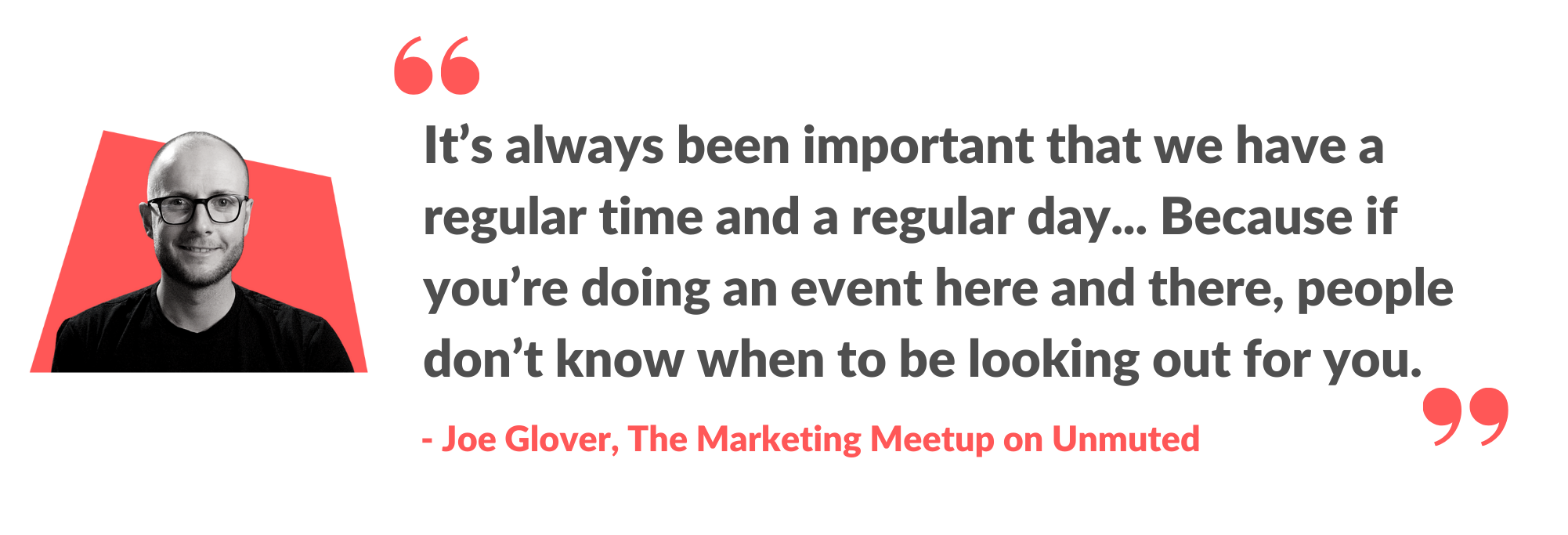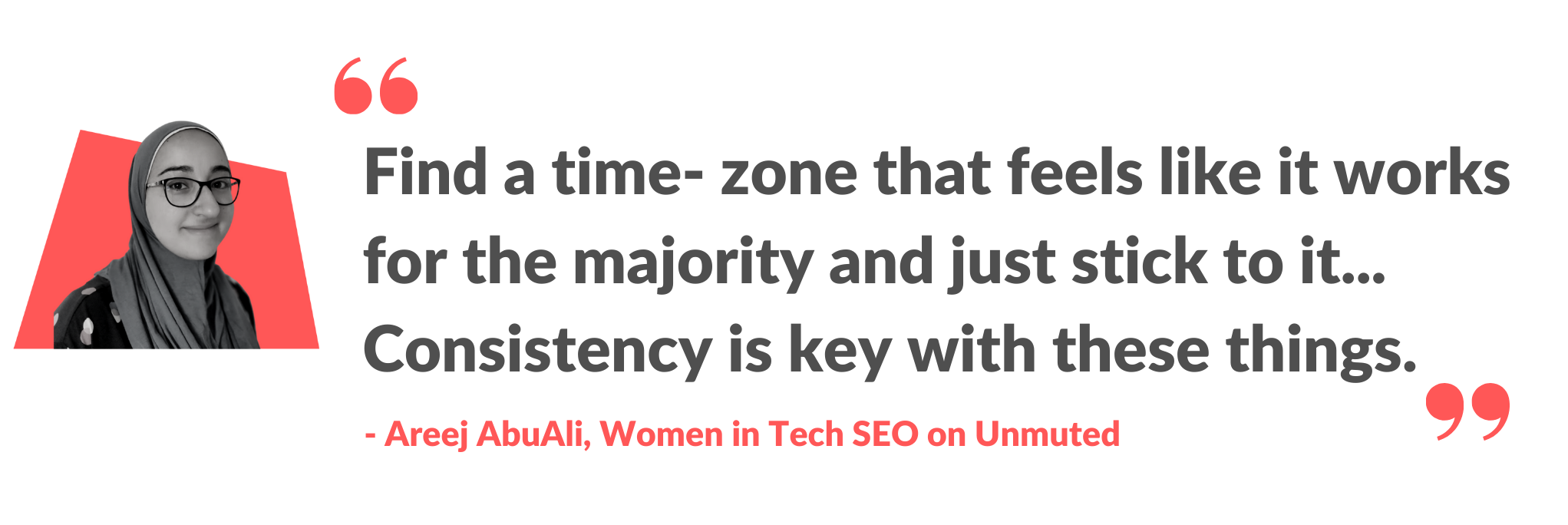Virtual Event Timing: When & How Long Should It Be?

Share
Time Your Virtual Events Like A Boss.
Virtual Events have taken the events industry by storm. They allow organisations, both large and small, to replicate the benefits, look, feel and interactivity of a traditional physical event, but online.
However, the success of a virtual event depends on a number of factors. Aside from content, one of the most important factors influencing a virtual event’s success is timing. The timing of your virtual event is the key to maximising your event’s attendance.
That’s why we’ve interrogated data on over 100 of our recent online and hybrid events, to help you understand exactly when and how long you should run your online events for to get the best results.
Here’s a quick summary of our findings across all industries, but keep reading to understand the best time to host your virtual event, what day you should host your virtual event and how long your event should be.
The best time to host your virtual event is between 1pm – 3:30pm on Mondays and Fridays.
The best duration for your virtual events is 2 – 4 hours.
But there’s so much more to think about. If this is something new to you, you might find yourself wondering; what’s the best day and time to host an online event? Let’s look at the three important time-related factors for the success of your virtual event and our data…
1. The best day to host a virtual event
Our data shows that Mondays and Fridays are typically the best days to host an online event. So if we’re talking typical B2B, it does looks like people are more likely to attend an online event and pay attention when it’s the start or end of their working week.
Please note: this is taking into consideration audience numbers AND engagement score. Never look at your attendee numbers alone.
If people aren’t also engaged with your content, then they’re not really interested. Not much of a success then, is it?
How Is Our Engagement Score Worked Out?
We calculate a variety of engagement factors across an event to work out an average score, including:
Number of questions
Number of poll submissions
Amount of time spent watching the event
Tuesdays, Wednesdays, Thursdays and Saturdays still have quite a consistent attendee and engagement rate however, so don’t worry too much if you have to host an event on these days instead. Based on our data we would definitely avoid hosting an online event on Sundays if you can.
If you’ve been running an event for a while, your audience may already have your brand associated with an event in a certain month.
Joe Glover, Founder of The Marketing Meetup emphasised the importance of regularity on our video series, Unmuted.

Key things to consider to help you choose the best day for your virtual event:
Your Audience
What impacts your target attendees during the year? Will they be tied-up during school holidays? Having a clear understanding of when your audience will be too busy will help you pinpoint when to avoid running and promoting your event.
Your Business
It may be obvious, but make sure your business is geared up to support your Virtual Event. Whether its availability of sales for follow-up calls or capitalising on a product launch, your event date(s) should be in sync with your entire business.
Your Competitors
It’s always worth checking to see if your competitors already have their big events in the calendar. Avoiding a clash makes sense, but you’ll also get a good idea as to when your target audience is in an event-attending mood.
Your Speakers
This is potentially a chicken and egg situation. If you are trying to land a high-profile external keynote speaker, you’ll need to check when they are available before deciding on a date.
Create Events That Generate Incredible Results
We'll Show You how2. The best time to start a virtual event
Based on our data, between 1pm – 3:30pm is the best time to start an online event. Although attendee numbers are higher early in the morning before 9:30, that engagement score does seem to stay quite low.
Numbers seem to plummet around lunch time – so we’d suggest avoiding hosting any online events around this time. Attendee and engagement rates seem to take a dip again from 4 – 5:30, which is when most people are likely travelling home from work, making their tea or running any errands.
If you’re considering running a virtual event later in the evening after 5:30pm, just be aware that attendee rates may be lower but that all important engagement appears to be quite consistent. But much like deciding on the date, the time of your event can rely so much on your audience.
Key things to consider to help you choose the best time for your virtual event:
Are they all likely to be from the same time zone? If not, and your content is live, identifying a time with a good overlap is key.
On our video series Unmuted, Areej AbuAli, Founder of Women in Tech SEO, explained how she prioritises the time-zone that works the majority of her global audience and sticks to it:

You could also try running your online event at different times for each time zone by making use of instant on-demand video taken from your first live event. Including engagement features like live chat to collect questions and allow later audiences to interact is a great way to add value.
It’s also worth considering how you can use the time of day to stand out or develop a creative message around your Virtual Event. Launching a Virtual Brunch Club or Virtual Networking Happy Hour automatically taps into your audience’s imagination and expected time of day/evening.
3. How long should a virtual event be?
Our data shows your virtual event should last between 2 – 4 hours, but anything up to a 5 hour duration can work well for engagement.
A pitfall to avoid here is assuming you can run a Virtual Event over a full day like many physical events. In a virtual setting, this just isn’t going to work. It is much harder for your attendees to dedicate their full focus on one tab of their device for a full day.
Whether it’s emails, colleagues or family, your audience is in their own environment with different priorities and distractions.
It all boils down to what type of virtual event you’re looking to run; will there be engagement features on there such as polls, games or live chats to break up the event? Will you have a section for networking or sponsor booths?
Key things to consider to help you choose the best duration for your virtual event:
Break Your Events Up
Instead of running one big annual event, break it into shorter and more frequent instalments. Perhaps one each quarter with a single topic of focus. This may mean your events target different segments of your overall audience and help establish your company as an expert in each area. These shorter sessions could last between 3 – 4 hours and feature keynotes, breakout sessions and live Q&A to generate in-depth discussion of the topic.
Split Your Event Over Two Days
A recent survey showed that almost half of event organisers opted for shorter multi-day events to avoid virtual format fatigue.
Again, each day could last between 3 – 4 hours and why not host a “virtual happy hour” on the evening of day one? This can give your attendees the chance to network and develop their professional relationships.
Linking the content together over the two days is important to keep your attendees engaged for the second day. For example, it could be featuring two high profile keynote speakers over the two days or presenting feedback or results from the first day, or perhaps using the second day to unveil a new product or service. Make sure you include a trailer or “tease” at the end of the first day to let your attendees know what’s coming on day two.
Host A Mix Of Live And On-Demand Event Content For A Limited Time Only
The live keynote sessions can help drive the interest, while other on-demand presentations will keep the attendees engaged at times that suit them. By hosting this content for a limited time, a week, for example, you are able to use the immediacy of a regular event to drive registrations. Using on-demand content will also help alleviate some of the “on-the-day” pressures for event organisers.
Something else to consider here would be to have a rota of live event hosts that are on hand to welcome attendees using live text or video chat. This would give your attendees the “live experience” and can help point them to the live and on-demand sessions.
Quick Takeaway
In summary, the timing of your virtual event is really important, and for this reason, several time-related factors must be considered when planning your event.
Firstly, when choosing the date of your virtual event, you must find a balance between the availability of your audience, speakers and your business’s capacity to provide support for the event. At the same time, keeping an eye on when your competitors’ event schedule is important to avoid clashes.
Secondly, it’s important to consider timezones when choosing the time to host your event. If you’re running the event live, choose a time that’s convenient for your audience across several timezones.
Lastly, the duration of your event needs to be considered. Breaking your virtual event up into smaller, bite-size chunks of content over a couple of days allows your audience to maintain focus.
Watch the Video
Like the article? Watch and share our summary video all about how to nail the timing of your virtual event…
If you’d like to learn more about virtual events, download out our new eBook, ‘How To Run A Virtual Event‘, for free below.
Inspired for your next online event?
See the streamGo platform in action!

